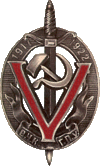Cheka facts for kids

Cheka badge as it was in 1922
|
|
| Agency overview | |
|---|---|
| Formed | 1917 |
| Preceding agency |
|
| Dissolved | (reorganized and renamed) 1922 |
| Superseding agency |
|
| Type | Secret police |
| Headquarters | 2 Gorokhovaya street, Petrograd Lubyanka Square, Moscow |
| Agency executive | |
| Parent agency | Council of the People's Commissars |
The Cheka was the first Soviet state security organization. It was created on 20 December 1917, after a decree issued by Vladimir Lenin. Its first leader aristocrat-turned-communist Felix Dzerzhinsky.
By late 1918, hundreds of Cheka committees had been created in the cities. Many thousands of dissidents, deserters, or other people were arrested, tortured or executed by Cheka groups. After 1922, Cheka groups underwent many reorganizations, as did the NKVD. Its members were called Chekists well into the late 1980s. With Vladimir Putin's rise to power, the reference to the FSB members as "Chekists" arose, particularly by Putin's political opponents, often with negative connotations.
From its start, the Cheka was an important military and security arm of the Bolshevik communist government. In 1921 the troops of the Cheka numbered 200,000. These troops policed and ran the Gulag system.
Name
The full name of the Cheka in 1918 was (in Russian) the "All-Russian Extraordinary Commission for Combating Counter-Revolution, Profiteering and Corruption".
A member of Cheka was called a "chekist" throughout the Soviet period, despite various official name changes. The term is still found in use in Russia today. For example, President Vladimir Putin has been referred to in the Russian media as a "chekist" due to his career in the KGB.
Images for kids
-
Members of the presidium of VCheKa (left to right) Yakov Peters, Józef Unszlicht, Abram Belenky (standing), Felix Dzerzhinsky, Vyacheslav Menzhinsky, 1921
-
Portrait of Martin Latsis on a Soviet postage stamp.
See also
 In Spanish: Checa para niños
In Spanish: Checa para niños






